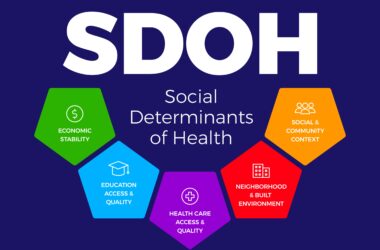The COVID-19 pandemic has brought to light the crucial interdependence between public health and economic prosperity. The pandemic has not only taken a toll on the global healthcare system but has also inflicted a severe blow to the global economy. If we have to pick the biggest takeaway, it is the need for nations to invest in their healthcare systems to ensure they are equipped to deal with future health emergencies.
The intrinsic link between public health and economic prosperity is undeniable. In this light, a nation’s well-being directly impacts its productivity, competitiveness, and overall economic performance. Conversely, a struggling public health system can impose substantial costs, hindering economic growth and development, especially in healthcare.
Today’s post underlines this relationship and explores why it is essential for nations to prioritize their healthcare systems for long-term economic growth and development.
But before that, here’s a trivia about the US healthcare industry that might catch your interest: the estimates of total healthcare spending in the United States is more than any country around the world. In fact, in 2022, their healthcare spending grew 4.1%, reaching $4.5 trillion or $13,493 per person.
Content Index:
- The Vital Signs Of A Robust Economy
- Lessons From COVID-19 – Key Takeaways
- Public Health vs. Business Interests
- The Future Of Healthcare – Assessing The Trends
- Let’s Look At The Bigger Picture – Environmental Health
- Does Investing In Public Health Qualify As Investing In Our Future?
The Vital Signs Of A Robust Economy
As mentioned earlier, poor public health exacts a significant economic toll. Chronic diseases, such as heart disease, diabetes, and more contribute to absenteeism and presenteeism (reduced productivity while at work), resulting in substantial losses for employers. For instance, heart disease and stroke are not only detrimental to health but also have a significant economic impact. According to the Centers for Disease Control and Prevention (CDC), these diseases cost the US healthcare system $216 billion annually, resulting in $147 billion in lost productivity.
Preventative care is a crucial aspect of healthcare that can help reduce the costs associated with chronic diseases. Individuals can notably reduce the likelihood of developing chronic diseases by investing in preventive measures, such as regular check-ups, screenings, and lifestyle interventions. This approach is particularly important for employers who want to prioritize the wellness of their employees, as preventative care has been shown to have numerous benefits, including improved productivity, lower healthcare costs, and reduced absenteeism. By taking a farseeing approach to healthcare trends, individuals and employers can work together to build a healthier, more productive workforce.
Lessons From COVID-19 – Key Takeaways
The COVID-19 pandemic is a worldwide reminder of the economic consequences of public health crises. Business disruptions, supply chain breakdowns, and reduced consumer spending collectively dealt a severe blow to the US economy. During the early stages of the pandemic, the actual gross domestic product (GDP) plunged by 9 percent, much steeper than the nearly 4 percent decline observed during the deepest point of the Great Recession.
While the nation gradually rebounded, the pandemic’s lasting impact on supply chains and consumer behavior underscored the need for resilience. Businesses must adapt, diversify supply networks, and embrace digital transformation to better withstand future public health emergencies.
Public Health vs. Business Interests
Navigating the delicate balance between public health measures and economic concerns is a complex challenge. While public health policies, such as lockdowns and restrictions, aim to safeguard the population, they can inadvertently disrupt business operations and economic activity. Thus, policymaking is a complex challenge that requires a collaborative approach from all stakeholders.
Effective policymaking requires a collaborative approach involving input from public health experts, business leaders, and policymakers. Government intervention and regulations must strike a balance, prioritizing public health while minimizing economic disruptions. Likewise, open dialogue and seeking common ground are crucial for sustainable solutions.
The Future Of Healthcare – Assessing The Trends
The healthcare landscape constantly evolves, driven by technological advancements and shifting consumer demands. Telemedicine and other emerging digital health solutions offer convenient, cost-effective alternatives to traditional healthcare delivery, potentially reducing healthcare costs and improving access.
Personalized medicine, tailoring treatments to an individual’s genetic makeup, holds promise for more effective and efficient care. However, the high costs associated with personalized medicine raise concerns about equitable access and affordability.
Investing in preventative care remains a long-term strategy for cost savings. By highlighting disease prevention and promoting healthy lifestyles, the burden on healthcare systems and associated costs can be alleviated.
Let’s Look At The Bigger Picture – Environmental Health
Environmental factors significantly impact public health, yet their economic implications often go overlooked. Climate change, air pollution, and water contamination contribute to diverse health issues, including respiratory diseases, cardiovascular problems, and cancer.
The economic costs of environmental degradation are substantial. Air pollution alone is estimated to cost the US economy over $200 billion annually due to increased healthcare industry expenses and productivity losses. Adopting sustainable business practices, such as reducing emissions and promoting renewable energy, can mitigate these costs while contributing to a healthier environment.
Does Investing In Public Health Qualify As Investing In Our Future?
The interdependence between public health and economic prosperity is undeniable. A nation’s economic well-being hinges on the health of its population, while a robust economy enables investments in public health infrastructure and services.
Embracing a holistic approach to business decision-making—one that considers public health implications—is crucial. Along the same line, encouraging cross-sector collaboration among government, healthcare providers, businesses, and communities can pave the way for innovative solutions that address public health challenges while supporting economic growth.
So, it is fair to conclude that investing in public health is an investment in our nation’s future. By prioritizing preventative care, environmental sustainability, and resilience against public health crises, we can create an ethical cycle of healthier citizens and a thriving economy. The time to act is now, for a healthier nation is a wealthier nation.











